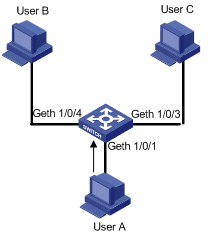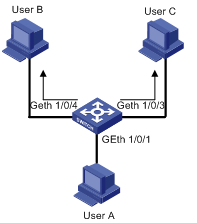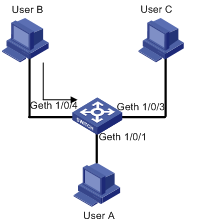- Table of Contents
-
- H3C WX3000 Series Unified Switches Switching Engine Configuration Guide-6W103
- 00-Preface
- 01-CLI Configuration
- 02-Login Configuration
- 03-Configuration File Management Configuration
- 04-VLAN Configuration
- 05-Auto Detect Configuration
- 06-Voice VLAN Configuration
- 07-GVRP Configuration
- 08-Basic Port Configuration
- 09-Link Aggregation Configuration
- 10-Port Isolation Configuration
- 11-Port Security-Port Binding Configuration
- 12-DLDP Configuration
- 13-MAC Address Table Management Configuration
- 14-MSTP Configuration
- 15-802.1x and System Guard Configuration
- 16-AAA Configuration
- 17-MAC Address Authentication Configuration
- 18-IP Address and Performance Configuration
- 19-DHCP Configuration
- 20-ACL Configuration
- 21-QoS-QoS Profile Configuration
- 22-Mirroring Configuration
- 23-ARP Configuration
- 24-SNMP-RMON Configuration
- 25-Multicast Configuration
- 26-NTP Configuration
- 27-SSH Configuration
- 28-File System Management Configuration
- 29-FTP-SFTP-TFTP Configuration
- 30-Information Center Configuration
- 31-System Maintenance and Debugging Configuration
- 32-VLAN-VPN Configuration
- 33-HWPing Configuration
- 34-DNS Configuration
- 35-Smart Link-Monitor Link Configuration
- 36-PoE-PoE Profile Configuration
- 37-Routing Protocol Configuration
- 38-UDP Helper Configuration
- 39-Acronyms
- 40-Index
- Related Documents
-
| Title | Size | Download |
|---|---|---|
| 13-MAC Address Table Management Configuration | 106.52 KB |
1 MAC Address Table Management
Introduction to MAC Address Table
Introduction to MAC Address Learning
Configuring MAC Address Table Management
Configuring a MAC Address Entry
Setting the Aging Time of MAC Address Entries
Setting the Maximum Number of MAC Addresses a Port Can Learn
Disabling MAC Address learning for a VLAN
Displaying and Maintaining MAC Address Table
Adding a Static MAC Address Entry Manually
![]()
l The term switch used throughout this chapter refers to a switching device in a generic sense or the switching engine of a unified switch in the WX3000 series.
l The sample output information in this manual was created on the WX3024. The output information on your device may vary.
l This chapter describes the management of static, dynamic, and blackhole MAC address entries. For information about the management of multicast MAC address entries, refer to Multicast in H3C WX3000 Series Unified Switches Switching Engine Configuration Guide.
Overview
Introduction to MAC Address Table
A switch is mainly used to forward packets at the data link layer, that is, transmit the packets to the corresponding ports according to the destination MAC address of the packets. To forward packets quickly, a switch maintains a MAC address table, which is a Layer 2 address table recording the MAC address-to-forwarding port association. Each entry in a MAC address table contains the following fields:
l Destination MAC address
l ID of the VLAN which a port belongs to
l Forwarding egress port numbers on the local switch
When forwarding a packet, a switch adopts one of the two forwarding methods based on the MAC address table entries.
l Unicast forwarding: If the destination MAC address carried in the packet is included in a MAC address table entry, the device forwards the packet through the forwarding egress port in the entry.
l Broadcast forwarding: If the destination MAC address carried in the packet is not included in the MAC address table, the device broadcasts the packet to all ports except the one receiving the packet.
Introduction to MAC Address Learning
MAC address table entries can be updated and maintained through the following two ways:
l Manual configuration
l MAC address learning
Generally, the majority of MAC address entries are created and maintained through MAC address learning. The following describes the MAC address learning process of the device:
1) As shown in Figure 1-1, User A and User B are both in VLAN 1. When User A communicates with User B, the packet from User A needs to be transmitted to GigabitEthernet 1/0/1. At this time, the device records the source MAC address of the packet, that is, the address “MAC-A” of User A to the MAC address table of the switch, forming an entry shown in Figure 1-2.
Figure 1-1 MAC address learning diagram (1)

Figure 1-2 MAC address table entry of the switch (1)

2) After learning the MAC address of User A, the device starts to forward the packet. Because there is no MAC address and port information of User B in the existing MAC address table, the device forwards the packet to all ports except GigabitEthernet 1/0/1 to ensure that User B can receive the packet.
Figure 1-3 MAC address learning diagram (2)

3) Because the device broadcasts the packet, both User B and User C can receive the packet. However, User C is not the destination device of the packet, and therefore does not process the packet. Normally, User B will respond to User A, as shown in Figure 1-4. When the response packet from User B is sent to GigabitEthernet 1/0/4, the device records the association between the MAC address of User B and the corresponding port to its MAC address table.
Figure 1-4 MAC address learning diagram (3)

4) At this time, the MAC address table of the device includes two forwarding entries shown in Figure 1-5. When forwarding the response packet, the device unicasts the packet instead of broadcasting it to User A through GigabitEthernet 1/0/1, because MAC-A is already in the MAC address table.
Figure 1-5 MAC address table entries of the switch (2)

5) After this interaction, the device directly unicasts the communication packets between User A and User B based on the corresponding MAC address table entries.
![]()
l Under some special circumstances, for example, User B is unreachable or User B receives the packet but does not respond to it, the device cannot learn the MAC address of User B. Hence, the device still broadcasts the packets destined for User B.
l The device learns only unicast addresses by using the MAC address learning mechanism but directly drops any packet with a broadcast source MAC address.
Managing MAC Address Table
Aging of MAC address table
To fully utilize a MAC address table, which has a limited capacity, the device uses an aging mechanism for updating the table. That is, the device starts an aging timer for an entry when dynamically creating the entry, and removes the MAC address entry if no more packets with the MAC address recorded in the entry are received within the aging time.
![]()
Aging timer only takes effect on dynamic MAC address entries.
Entries in a MAC address table
Entries in a MAC address table fall into the following categories according to their characteristics and configuration methods:
l Static MAC address entry: Also known as permanent MAC address entry. This type of MAC address entries are added/removed manually and can not age out by themselves. Using static MAC address entries can reduce broadcast packets remarkably and are suitable for networks where network devices seldom change.
l Dynamic MAC address entry: Dynamic MAC address entries age out after the configured aging time. They are generated by the MAC address learning mechanism or configured manually.
l Blackhole MAC address entry: Blackhole MAC address entries are configured manually. The device discards the packets destined for or originated from the MAC addresses contained in blackhole MAC address entries.
Table 1-1 lists the different types of MAC address entries and their characteristics.
Table 1-1 Characteristics of different types of MAC address entries
|
MAC address entry |
Configuration method |
Aging time |
Reserved or not at reboot (if the configuration is saved) |
|
Static MAC address entry |
Manually configured |
Unavailable |
Yes |
|
Dynamic MAC address entry |
Manually configured or generated by MAC address learning mechanism |
Available |
No |
|
Blackhole MAC address entry |
Manually configured |
Unavailable |
Yes |
Configuring MAC Address Table Management
Configuration Task List
Complete the following tasks to configure MAC address table management:
|
Task |
Remarks |
|
Required |
|
|
Optional |
|
|
Setting the Maximum Number of MAC Addresses a Port Can Learn |
Optional |
|
Optional |
Configuring a MAC Address Entry
You can add, modify, or remove a MAC address entry, remove all MAC address entries concerning a specific port, or remove specific type of MAC address entries (dynamic or static MAC address entries).
You can add a MAC address entry in either system view or Ethernet port view.
Adding a MAC address entry in system view
Follow these steps to add a MAC address entry in system view:
|
To do… |
Use the command… |
Remarks |
|
Enter system view |
system-view |
— |
|
Add a MAC address entry |
mac-address { static | dynamic | blackhole } mac-address interface interface-type interface-number vlan vlan-id |
Required |
![]()
l When you add a MAC address entry, the port specified by the interface argument must belong to the VLAN specified by the vlan argument in the command. Otherwise, the entry will not be added.
l If the VLAN specified by the vlan argument is a dynamic VLAN, after a static MAC address is added, it will become a static VLAN.
Adding a MAC address entry in Ethernet port view
Follow these steps to add a MAC address entry in Ethernet port view:
|
To do… |
Use the command… |
Remarks |
|
Enter system view |
system-view |
— |
|
Enter Ethernet port view |
interface interface-type interface-number |
— |
|
Add a MAC address entry |
mac-address { static | dynamic | blackhole } mac-address vlan vlan-id |
Required |
![]()
l When you add a MAC address entry, the current port must belong to the VLAN specified by the vlan argument in the command. Otherwise, the entry will not be added.
l If the VLAN specified by the vlan argument is a dynamic VLAN, after a static MAC address is added, it will become a static VLAN.
Setting the Aging Time of MAC Address Entries
Setting aging time properly helps effective utilization of MAC address aging. The aging time that is too long or too short affects the performance of the device.
l If the aging time is too long, excessive invalid MAC address entries maintained by the device may fill up the MAC address table. This prevents the MAC address table from being updated with network changes in time.
l If the aging time is too short, the device may remove valid MAC address entries. This decreases the forwarding performance of the device.
Follow these steps to set the aging time of MAC address entries:
|
To do… |
Use the command… |
Remarks |
|
Enter system view |
system-view |
— |
|
Set the aging time of MAC address entries |
mac-address timer { aging age | no-aging } |
Required The default aging time is 300 seconds. |
Normally, you are recommended to use the default aging time, namely, 300 seconds. The no-aging keyword specifies that MAC address entries do not age out.
![]()
MAC address aging configuration applies to all ports, but only takes effect on dynamic MAC addresses that are learnt or configured to age.
Setting the Maximum Number of MAC Addresses a Port Can Learn
The MAC address learning mechanism enables the device to acquire the MAC addresses of the network devices on the segment connected to the ports of the device. By searching the MAC address table, the device directly forwards the packets destined for these MAC addresses through the hardware, improving the forwarding efficiency. A MAC address table too big in size may prolong the time for searching MAC address entries, thus decreasing the forwarding performance of the device.
By setting the maximum number of MAC addresses that can be learned from individual ports, the administrator can control the number of the MAC address entries the MAC address table can dynamically maintain. When the number of the MAC address entries learnt from a port reaches the set value, the port stops learning MAC addresses.
Follow these steps to set the maximum number of MAC addresses a port can learn:
|
To do… |
Use the command… |
Remarks |
|
Enter system view |
system-view |
— |
|
Enter Ethernet port view |
interface interface-type interface-number |
— |
|
Set the maximum number of MAC addresses the port can learn |
mac-address max-mac-count count |
Required By default, the number of the MAC addresses a port can learn is not limited. |
![]()
Specifying the maximum number of MAC addresses a port can learn disables centralized MAC address authentication and port security on the port. On the other hand, if you enable centralized MAC address authentication and port security on a port, you cannot specify the maximum number of MAC addresses the port can learn.
Disabling MAC Address learning for a VLAN
You can disable a switch from learning MAC addresses in specific VLANs to improve stability and security for the users belong to these VLANs and prevent unauthorized accesses.
Follow these steps to disable MAC address learning for a VLAN:
|
To do… |
Use the command… |
Remarks |
|
Enter system view |
system-view |
— |
|
Enter VLAN view |
vlan vlan-id |
— |
|
Disable the switch from learning MAC addresses in the VLAN |
mac-address max-mac-count 0 |
Required By default, the device learns MAC addresses in every VLAN. |
![]()
l If the VLAN is configured as a remote probe VLAN used by port mirroring, you can not disable MAC address learning of this VLAN. Similarly, after you disable MAC address learning, this VLAN can not be configured as a remote probe VLAN.
l Disabling the MAC address learning function of a VLAN takes no effect on enabling the centralized MAC address authentication on the ports that belong to the VLAN.
Displaying and Maintaining MAC Address Table
|
To do… |
Use the command… |
Remarks |
|
Display information about the MAC address table |
display mac-address [ display-option ] |
The display command can be executed in any view. |
|
Display the aging time of the dynamic MAC address entries in the MAC address table |
display mac-address aging-time |
Configuration Example
Adding a Static MAC Address Entry Manually
Network requirements
The server connects to the device through GigabitEthernet 1/0/2. To prevent the device from broadcasting packets destined for the server, it is required to add the MAC address of the server to the MAC address table of the device, which then forwards packets destined for the server through GigabitEthernet 1/0/2.
l The MAC address of the server is 000f-e20f-dc71.
l Port GigabitEthernet 1/0/2 belongs to VLAN 1.
Configuration procedure
# Enter system view.
<device> system-view
# Add a MAC address, with the VLAN, ports, and states specified.
[device] mac-address static 000f-e20f-dc71 interface GigabitEthernet 1/0/2 vlan 1
# Display information about the current MAC address table.
[device] display mac-address interface GigabitEthernet 1/0/2
MAC ADDR VLAN ID STATE PORT INDEX AGING TIME(s)
000f-e20f-dc71 1 Config static GigabitEthernet1/0/2 NOAGED
000f-e20f-a7d6 1 Learned GigabitEthernet1/0/2 AGING
000f-e20f-b1fb 1 Learned GigabitEthernet1/0/2 AGING
000f-e20f-f116 1 Learned GigabitEthernet1/0/2 AGING
--- 4 mac address(es) found on port GigabitEthernet1/0/2 ---

